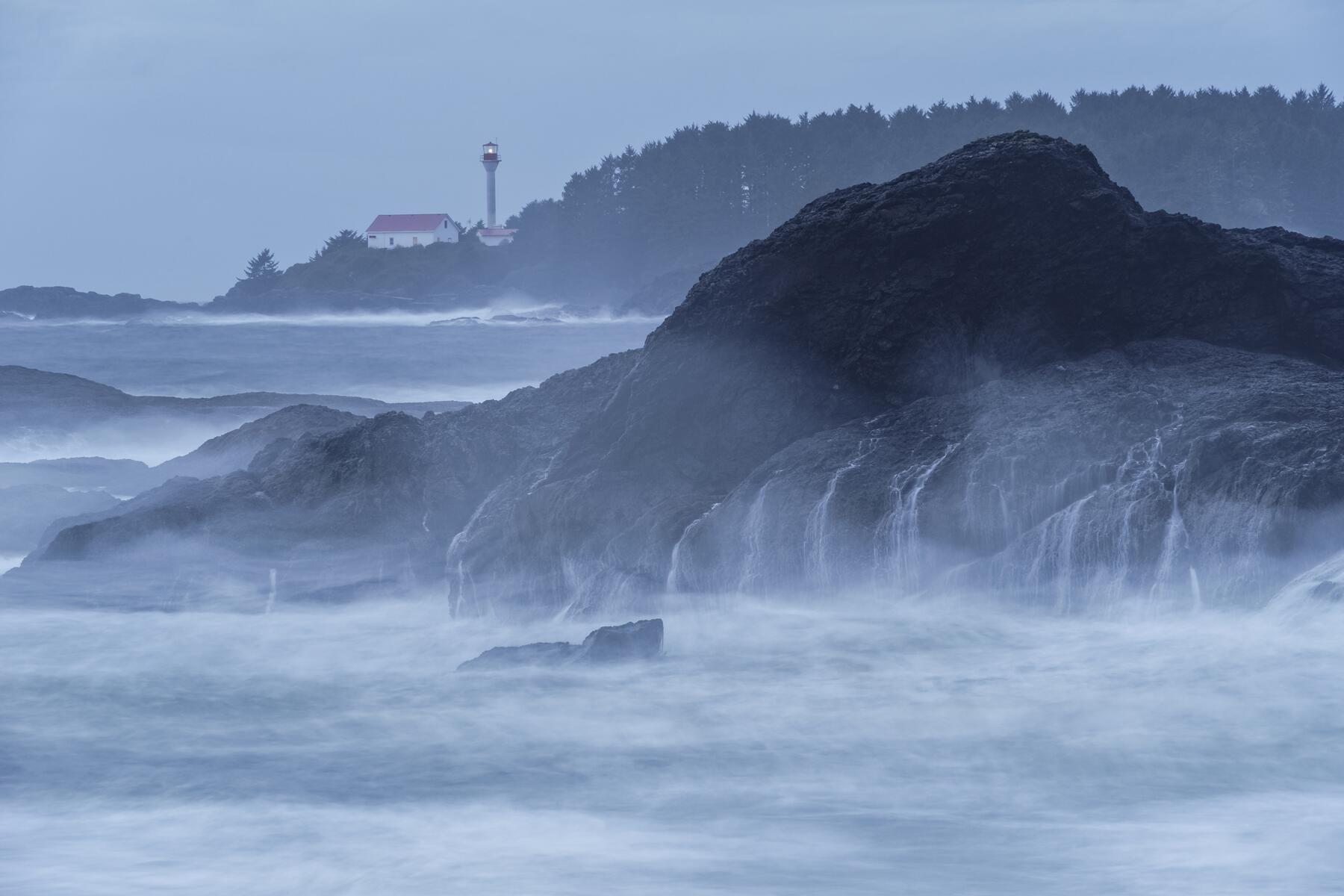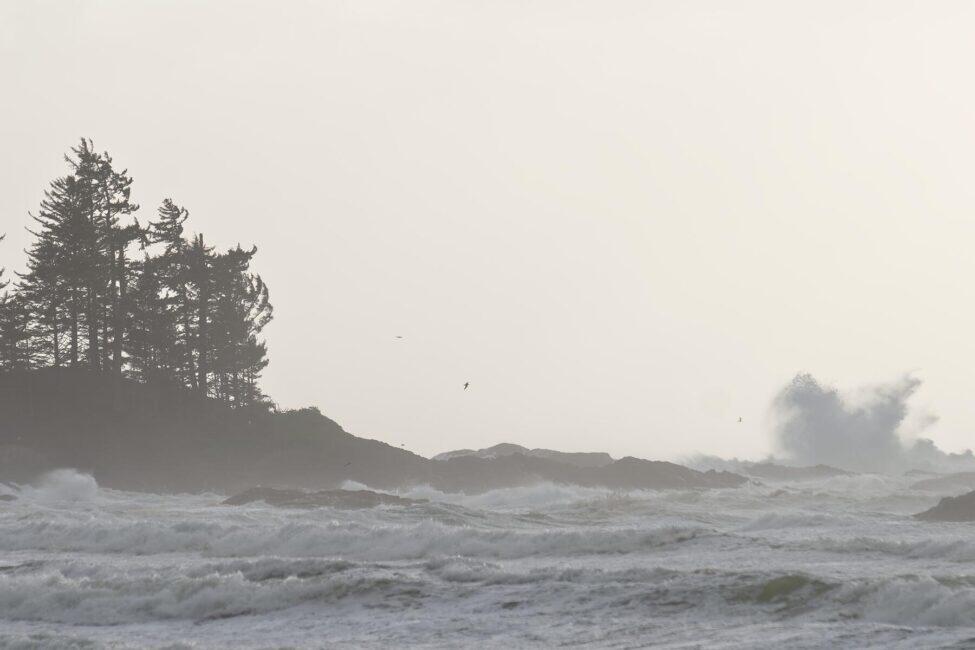Storm-watching getaways are trending in the bohemian surf hideaway of Tofino—just watch out for the big one.
When kids return to school and the tour groups depart for sunnier places, Vancouver Island’s spectacular west coast settles into a long, wet winter. Towering groves of redwoods drip a steady rain, and hot springs steam under smoke-colored skies. In the bohemian surf town of Tofino, fishermen nurse pints in a bar called The Hatch, by a harbor where seaplanes arrive from Vancouver during the warmer months. It’s quiet, mostly, until suddenly, it’s not. Because each time foul weather rolls in, waves detonate on the shoreline with the sonorous thud of incoming ballistic missiles.
“It’s mother nature performing,” says Charles McDiarmid, owner of the Wickaninnish Inn, whose location on Chesterman Beach is known for powerful surf. “On a big storm the whole beach will be covered, with a lot of wood debris getting tossed around,” he says. When a wave picks up the snapped trunk of a Sitka spruce, it hurls the tree towards the shore with an astonishing force. “It smashes right into the bedrock, vibrating with this low bass sound that cuts through the shrieking of the storm,” McDiarmid says.
It’s quiet, mostly, until suddenly, it’s not.
Why are waves here so explosive? Most waves are created by wind, which pushes seawater into ripples that converge and amplify as they travel. If the ocean is the waves’ racetrack, open water is a straightaway tailor-made to accelerate them. When you’re standing on the seacoast of Vancouver Island, it’s a clear westward shot all the way to Japan, more than 4,000 miles of open water that can turn wind-driven swells into raging monsters the size of a house.
Recommended Fodor’s Video
And where local fisherman saw enveloping waves, McDiarmid’s father saw an opportunity. He built the Wickaninnish Inn in 1996 with floor-to-ceiling windows designed for viewing the roaring, foam-spitting show below. Now, the Relais & Châteaux–listed property is one of a handful of west-coast hotels drawing travelers for the spectacle. And while Vancouver Island’s wettest season may seem like a hard sell to vacationers, the strategy has paid off for the Wickaninnish Inn; McDiarmid now gets more returning visitors in winter than any other time of year.

Storm watchers at the Wickanninish Inn enjoy the show from cozy, ocean-facing rooms fitted with fireplaces, or suit up in foul-weather gear to venture onto the beach below. Just down the coast is another storm-watching destination, Long Beach Lodge on Cox Bay, a beguiling, sandy beach swept by some of Vancouver Island’s biggest waves. On the wildest days, 36-foot surf tears at the pale coastline; the lodge’s Great Room has double-paned glass that shivers with each crashing wave, along with a roaring fire to fend off the winter chill.
Not everyone stays inside by a fire. “Winter is the season for the true surfer,” says Shandy Kariatsumari, a Tofino surfer who is the educational director for Surf Canada. In more than twenty years of surfing the west coast of Vancouver Island, she’s paddled out in snow, hail, and 60-knot winds. “It’s when the storms are, and the wind and the storms are what generate the surf.”
“Winter is the season for the true surfer.”
For Kariatsumari, the big waves are a thrill that rewards suiting up on even the coldest days. “You’ve got this wall of water,” she says, “foam that’s taller than buildings—you feel the floor and the power of each wave.” In big conditions, when she senses the ocean’s surging force through her thin board, she’s riding the concentrated might of storms that once jostled boats in Japan, Alaska, and Australia.
The power of the ocean might draw surfers and storm-watchers from around the world, but in Vancouver Island, waves can also bring terrible destruction. First Nations people from across the British Columbia coast have passed down stories about a devastating tsunami that arrived here in 1700, a wave so big it reverberated in Japan. In a story about apocalyptic waves published by The New Yorker, journalist Kathryn Shultz recounted a tale from Huu-ay-aht First Nation Chief Louis Nookmis, who described an entire Vancouver Island people wiped out by that 1700 tsunami. “It was nighttime at the time the land shook,” Nookmis said of the event that swallowed the Pachena Bay tribe. “They sank all at once, were all drowned; not one survived.”

Tsunamis are no regular waves, of course—they’re caused by earthquakes, not wind action at sea. And while scientists estimate another massive event is due within 200 years, it doesn’t seem to frighten the most daring travelers, or locals, away from Vancouver Island’s most turbulent spots.
If the big one does come, the island offers well-marked escape routes. Blue and white tsunami evacuation signs around Tofino show a cartoon human figure fleeing a series of ominous incoming waves, headed, presumably, for the relative safety of higher ground. But one sign on the outskirts of the city has a small, black sticker slapped onto it, a tiny act of vandalism that offers an alternate suggestion. Underneath the sensible person bolting towards the hills, a tiny surfer with board in hand jogs straight into the waves.



